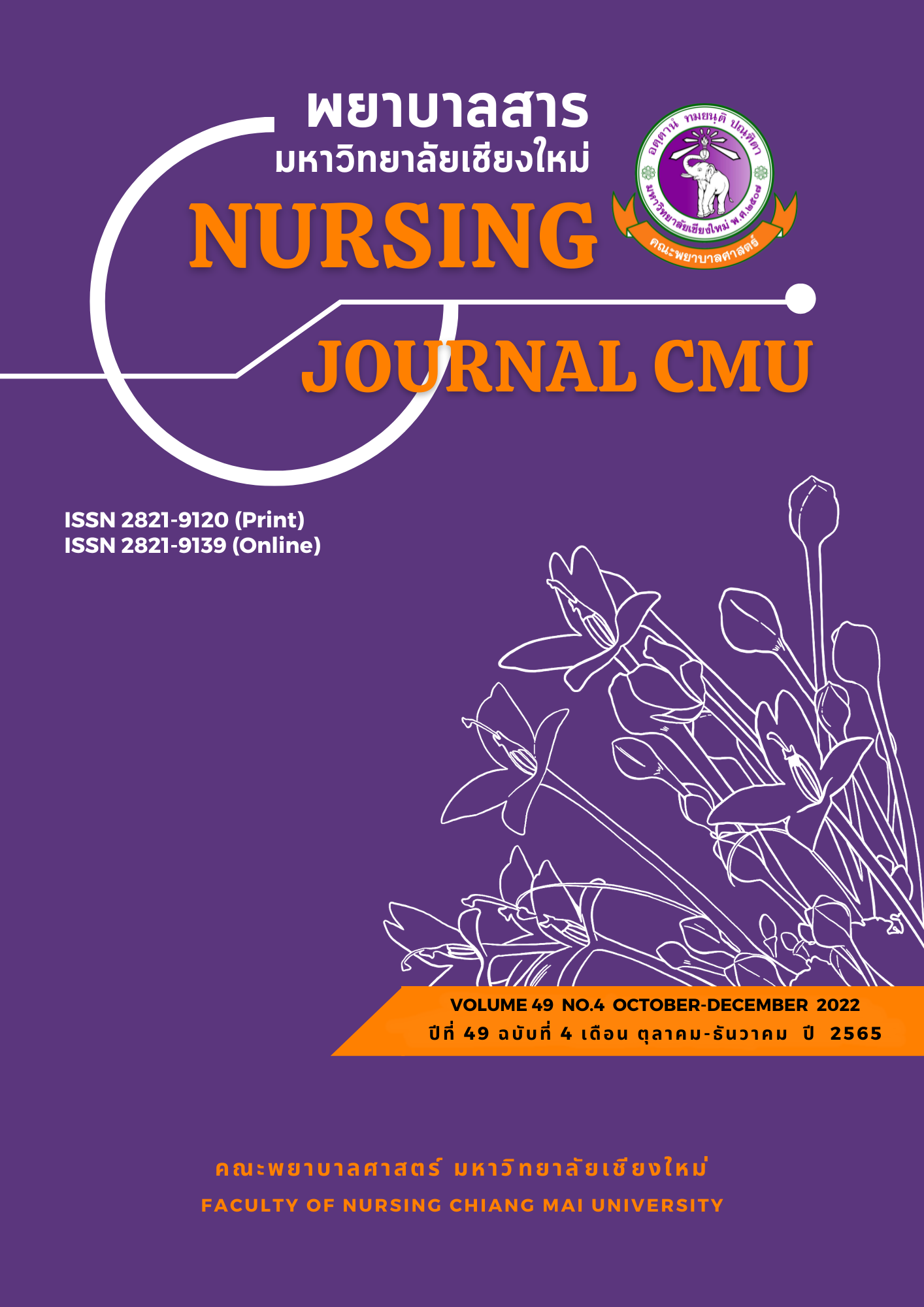The Effects of a Simulation-Based Learning Program on Knowledge and Communication Skills for Patient Safety Among Perioperative Nurses
Keywords:
Simulation-based learning program, Communication knowledge for patient safety, Communication skills for patient safety, Perioperative nursesAbstract
The purpose of this quasi-experimental research was to study the effect of a simulation-based learning (SBL) program on knowledge and communication skills for patient safety among perioperative nurses. Twelve professional nurses working in the operating room at tertiary hospital were purposively recruited. The instruments used in the research were 1) an experimental instrument consisting of the SBL program to enhance knowledge and communication skills among perioperative nurses in three scenarios, validated by five experts; the program testing was conducted with two nurses who were not recruited for the study; and 2) the tools used to collect data, composed of demographic questionnaires, the Safety Communication Knowledge Assessment, and the behavioral observation record form. The safety communication knowledge assessment tool was validated by 5 experts; the content validity index (CVI) was 0.81 and 0.80, respectively. Reliability testing for the Safety Communication Knowledge Assessment by Kuder-Richardson 20 was 0.80Data were analyzed using descriptive statistics and the Wilcoxon Signed Rank Test.
The results showed that the safety communication knowledge of perioperative nurses after participating in the SBL program significantly increased (Z = -2.836, p = .005). After using the SBL program for knowledge and communication skills related to patient safety, the post-test’s median score (Mdn = 12.5, IQR = 4.5) was higher than the pre-test’s median score (Mdn = 11, IQR = 4.0). After participating in the SBL program, the overall practice of communication skills for patient safety among perioperative nurses was 94.44%.
This finding shows that SBL programs can enhance the knowledge and skill of safety communication for perioperative nurses.
References
Abildgren, L., Lebahn-Hadidi, M., Mogensen, C. B., Toft, P., Nielsen, A. B., Frandsen, T. F., … Hounsgaard, L. (2022). The effectiveness of improving healthcare teams’ human factor skills using simulation-based training: A systematic review. Advances in Simulation, 7(12), 1-18. doi: 10.1186/s41077-022-00207
Aebersold, M., Tschannen, D., & Sculli, G. (2013). Improving nursing student s’ communication skills using crew resource management strategies. Journal of Nursing Education, 52(3), 125-130.
Anonymous. (2020). Annual Risk Report Statistics 2016 - 2020. Author. (in Thai)
Benner, P. (1984). From novice to expert: Excellence and power in clinical nursing practice. California, NY: Addison-Wesley.
Braaf, S., Manis, E., Finch, S., Riley, R., & Munro, F. (2012). Communication failure across the perioperative pathway. International Journal of Person-Centered Medicine, 2(4), 698-706.
Braaf, S., Riley, R., & Manias, E. (2015). Failures in communication through documents and documentation across the perioperative pathway. Journal of Clinical Nursing, 24, 1874-1884.
Brubacher, S. P., Powell, M., Skouteris, H., & Guadagno, B. (2015). The effect of e-simulation interview training on teachers' use of open-ended questions. Child Abuse & Neglect, 43, 95-103. doi: 10.1016/j.chiabu.2015.02.004
Chansa, S. (2017). The effects of effective communication and teamwork on patient safety management of staff nurses at one government hospital in Bangkok metropolis. Journal of The Royal Thai Army Nurses, 18(Suppl.), 299-307.
Chuthong, L. (2018). Registered nurses' competencies in communication for patient safety in tertiary hospitals, Southern Thailand. Songkhla: Prince of Songkla University.
Cook, D. A. (2014). How much evidence does it take? A cumulative meta-analysis of outcomes of simulation-based education. Medical Education, 48(8), 750-760. doi: 10.1111/medu.12473
Gawande, A. A., Michael, J. Z., David, M. S., & Troyen, A. B. (2003). Analysis of errors reported by surgeons at three teaching hospitals. Surgical Outcomes Research, 133(6), 614-21.
Grossman, P., Compton, C., Igra, D., Ronfeldt, M., Shahan, E., & Williamson, P. (2009). Teaching practice: A cross-professional perspective. Teachers College Record, 111(9), 2055-2100.
Kang, E., Massey, D., & Gillespie, B. M. (2015). Factors that influence the non-technical skills performance of scrub nurses: A prospective study. Advance Nursing, 71(12), 2846-2857. doi: 10.111/ jan.12743
Kolb, D. A. (1984). Experiential learning: Experience as the source of learning anddevelopment. Englewood Cliffs, NJ: Prentice Hall. Retrieved from http://academic.regis.edu/ed205/Kolb.pdf
Krittayapoositpot, N. (2021). The achievement of the operating nurses' teaching program in Surat Thani hospital. Maharaj Nakhon SI Thammarat Medical Journal, 5(1), 1-12. (in Thai)
Kunalasiri, T. (2015). Communication type to optimize surgical teamwork effectiveness within operating theater in private hospital in Nakonsawan (Master’s thesis). Silpakorn University. Retrieved from http://ithesisir.su.ac.th/dspace/bitstream/123456789/164/1/ (in Thai)
O’Donnell, J. M., Decker, S., Howard, V., Levett-Jones, T., & Miller, C. W. (2014). NLN/Jeffries simulation framework state of the science project: Simulation learning outcomes. Clinical Simulation in Nursing, 10(7), 373-382.
Olga, C., Nicole, H., Matthias, S., Doris, H., Tina S., & Frank, F. (2020). Simulation-based learning in higher education: A meta-analysis. Journal Indexing and Metrics, 90(4), 499–541. doi: 10.3102/0034654320933544
O’shea. (1998). Relationship-building skill. Boston: McGraw hill Irwin.
Phaothipchan, K., Pinchaliew, D., & Putthapitakphon, S. (2015). The relationships between communication skills, safety competency, and patient safety management of staff nurses at an autonomous university hospital in Bangkok Metropolis. Journal of the Police Nurses, 7(1), 210-222. (in Thai)
Schuster, P. M. H., & Nykolyn, L. (2010). Communication for nurses: How to prevent harmful events and promote patient safety. Philadelphia: F. A. Davis Co.
Siwawut, J., Thiangchanya, P., & Thongsuk, P. (2020). Non-technical skills of perioperative nurses for patient safety in Tertiary Hospital, Thailand. Nursing Journal, 47(4), 458-469. (in Thai)
Suwanaphum, S., Angkhanit, M., & Sornboon, A. (2020). Competency in operating room nurses and nursing service practices that concern patient safety as per nurse’s perception, Roiet Hospital. Journal of Nursing and Health Care, 38(3), 51-61. (in Thai)
Thai Perioperative Nurses Association. (2011). Competency of perioperative nurses. Bangkok: TPNA. (in Thai)
Downloads
Published
How to Cite
Issue
Section
License
Copyright (c) 2022 Nursing Journal

This work is licensed under a Creative Commons Attribution-NonCommercial-NoDerivatives 4.0 International License.
บทความที่ได้รับการตีพิมพ์เป็นลิขสิทธิ์ของวารสารพยาบาลสาร
ข้อความที่ปรากฏในบทความแต่ละเรื่องในวารสารวิชาการเล่มนี้เป็นความคิดเห็นส่วนตัวของผู้เขียนแต่ละท่านไม่เกี่ยวข้องกับมหาวิทยาลัยเชียงใหม่ และคณาจารย์ท่านอื่นๆในมหาวิทยาลัยฯ แต่อย่างใด ความรับผิดชอบองค์ประกอบทั้งหมดของบทความแต่ละเรื่องเป็นของผู้เขียนแต่ละท่าน หากมีความผิดพลาดใด ๆ ผู้เขียนแต่ละท่านจะรับผิดชอบบทความของตนเองแต่ผู้เดียว






